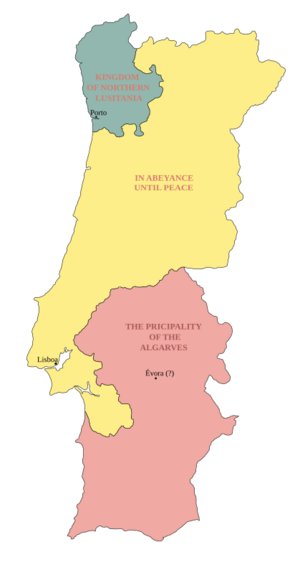Treaty of Fontainebleau (October 1807) facts for kids
The Treaty of Fontainebleau was a secret agreement signed on October 27, 1807. It was signed in Fontainebleau, France. The agreement was between King Charles IV of Spain and the French Emperor Napoleon.
Under this treaty, the royal family of Portugal, the House of Braganza, was to be removed from the Kingdom of Portugal. The country would then be divided into three parts. Within seven months, the government of Spain fell apart. Two Spanish kings gave up their thrones. In August 1808, Napoleon made his brother Joseph the new King of Spain.
Don Eugenio Izquierdo, who represented King Charles IV, and Marshal Géraud Duroc, who represented Napoleon, worked out the treaty. It had 14 main parts and extra rules about how many soldiers would be used for the planned invasion of Portugal.
Some historians believe Napoleon never truly planned to follow all parts of the treaty. He wanted to take over Portugal. But his main goal might have been to secretly move a large French army into Spain. This would make it easier for him to take control of Spain later.
Contents
Why the Treaty Was Signed
After Napoleon failed to invade Great Britain in 1806, he created the Continental Blockade. This rule stopped all trade of British goods across Europe. Portugal, which had always been a friend of England, refused to follow this rule.
To invade Portugal, Napoleon needed his soldiers to march through Spain. This is why he needed to make a treaty with Spain.
Main Parts of the Treaty
The Treaty of Fontainebleau had several important articles. They explained how Portugal would be divided and who would get control of different areas.
Dividing Portugal
- The area of Entre-Douro-e-Minho and the city of Oporto would be given to the King of Etruria. He would be called the King of North Lusitania.
- The province of Alentejo and the Kingdom of the Algarves would go to Manuel Godoy. He was the Prime Minister of Spain and a close friend of King Charles IV's wife. Godoy was known as the Príncipe de la Paz (Prince of Peace). He would also get the title of Prince of the Algarves. Napoleon did not like Godoy, but he saw him as someone who would help him take over Spain.
- The areas of Beira, Tras-os-Montes, and Portuguese Estremadura would be held onto for a while. Their future would be decided later, after a general peace was made.
Rules for New Rulers
- The new Kingdom of Northern Lusitania and the Principality of the Algarves would be passed down to the rulers' children. This would follow Spanish inheritance laws.
- If there were no legal heirs, these lands would return to the Spanish throne. They could never be ruled by the same person.
- Both new areas would remain under the protection of the Spanish king. They could not start wars or make peace without his permission.
- If the areas of Beira, Tras-os-Montes, and Portuguese Extremadura were returned to the Portuguese royal family later, their new ruler would also follow these same rules. This might happen if Portugal gave up Gibraltar, Trinidad, and other colonies to the English.
Other Agreements
- The King of Etruria would give his kingdom and all his property to the French Emperor.
- Once Portugal was taken over, new rulers would appoint people to draw the exact borders between their lands.
- All Spanish land south of the Pyrenees mountains would be protected by the French.
- The King of Spain would receive the title "King of the two Americas" within three years.
- Islands, colonies, and other lands owned by Portugal overseas would be divided between Spain and France.
- The treaty was secret. It had to be officially approved in Madrid, Spain, within 20 days of being signed.
Soldiers for the Invasion
The treaty also detailed the soldiers needed for the invasion. France would provide 25,000 foot soldiers and 3,000 cavalry (soldiers on horseback). Spain would provide 24,000 foot soldiers, 30 cannons, and 3,000 cavalry.
Spanish and French soldiers would meet at Alcantara and then march to Lisbon. Other Spanish troops would occupy different parts of Portugal. A large group of 40,000 men would gather at Bayonne. This was to prevent any interference from England or resistance from Portugal.
What Happened Next
General Junot's French army entered Lisbon on November 30. The Portuguese royal family quickly left for Brazil. They stayed there until 1821.
In 1808, France began to take over Spain. This led to a major conflict known as the Peninsular War.
See also
 In Spanish: Tratado de Fontainebleau (1807) para niños
In Spanish: Tratado de Fontainebleau (1807) para niños


